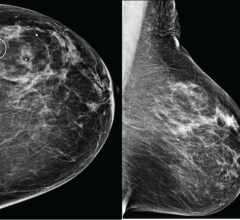
The inherent spectral capabilities of Mayo Clinic's new third-generation photon-counting CT research scanner allows clear visualization of the intact portions of the coronary artery lumen (arrowhead) by reducing the bright signal from the dense coronary calcifications (arrows). Spectral CT is able to bin photos on different energies that can be used to enhance or subtract chemical elements from the images based on their spectral signature, such as calcium shown here, and iodine.
July 14, 2021 — Performing the first cardiac scan on their new photon-counting detector computed tomography (CT) scanner was a once-in-a-career moment for Joel (J.G.) Fletcher, M.D., and Cynthia McCollough, Ph.D. The medical and scientific directors, respectively, of the CT Clinical Innovation Center describe the arrival of this latest research CT system as a major milestone in CT imaging, one where Mayo Clinic is again at the forefront.
"The use of photon-counting detectors in CT scanners is really a reinvention of CT imaging because the X-ray detector is the secret sauce that determines the quality of an image, somewhat like how the number of megapixels in your phone camera determines the quality of your photo," McCollough explained. "The images that we are seeing are incredible. We can appreciate structures that were simply too small to be resolved with previous detector technologies."
Although used in other fields, including high-energy physics and nuclear medicine, photon-counting detectors previously could not be used in a clinical CT scanner because they could not keep up with the rate of photons reaching the detector. This meant that the many advantages of this detector type could not be realized in patient CT imaging.
Use of Photon Counting to Enhance Cardiac CT
The research systems that the Mayo team has been investigating have overcome this challenge, and the newest-generation system takes another big step closer to clinical use. The system uses a unique geometry to perform state-of-the-art cardiac imaging. To get clear, crisp images of the heart and blood vessels, the system needs to be fast.
"And this system is extremely fast," McCollough said. "Cardiac imaging is like taking a photograph of a bicycle rider going by and wanting to count the number of spokes in the wheel, but the spokes are blurred because they were moving. With the new system, we can capture a small fraction of one heartbeat, which freezes the motion."
Mayo Helped Develop Photon-counting CT Technology
The CT Clinical Innovation Center, established by Fletcher and McCollough in 2004 at Mayo Clinic in Rochester, has been involved for almost a decade in discovering how the emerging technology of photon-counting-detector CT might benefit patients. The work is part of a collaboration with Siemens Healthineers, which developed the prototype system.
Mayo Clinic in Rochester installed the world's first photon-counting-detector CT system capable of human imaging in 2014. The first research studies in humans began in August 2015. Since then, the center has worked closely with the manufacturer to evaluate the clinical potential of the technology.
A second-generation prototype debuted at Mayo in 2020. This system addressed many of the design limitations of the first system. The third-generation research system — the first of its kind in North America — has been up and running since April 2021 as part of the ongoing research collaboration.
In April, Mayo Clinic performed its first cardiac scan on the new system. The completion of that exam elicited a round of applause from the research team.
Photon-counting CT Will be the Next major Advance in Radiology
"This type of advance in an imaging modality only comes along every couple of decades," Dr. Fletcher says, citing spiral CT, multidetector-row CT and dual-energy CT as previous advancements in CT imaging's evolution since Mayo Clinic performed the first patient CT scan in North America in 1973. "It's a special time in all of our careers when we have these paradigm-shifting technical advances."
Fletcher predicts that over the next five or 10 years, photon-counting-detector CT will lead to major advances in medical imaging that will result in improved patient care.
The CT Clinical Innovation Center has partnered with radiologists to create research teams in nine subspecialities, with each team thinking about how it can apply this technology to improve patient care.
"We are beginning to figure out what the best uses of photon-counting-detector CT are," Fletcher said, citing improved diagnosis of lung and vascular diseases as two areas that are clearly benefiting from the sharper images.
Related Advances in Photon-counting CT Systems:
VIDEO: New Advances in CT Imaging Technology — Interview with Cynthia McCollough, Ph.D.
VIDEO: Photon Counting Detectors Will be the Next Major Advance in Computed Tomography — Interview with Todd Villines, M.D.
Key Trends in Cardiac CT at SCCT 2020
GE Healthcare Pioneers Photon Counting CT with Prismatic Sensors Acquisition
Top Trend Takeaways in Radiology From RSNA 2020
VIDEO: Advances in Cardiac CT Imaging — Interview with David Bluemke, M.D.


 December 10, 2025
December 10, 2025 









